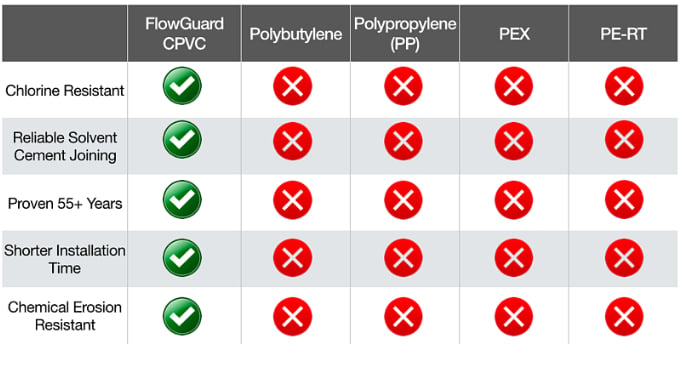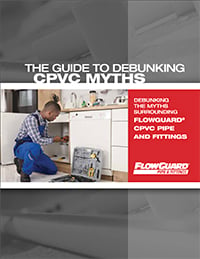How does FlowGuard® CPVC compare to other plastics?
Years of research, testing and real world applications show clear differences in material performance and overall suitability for hot and cold plumbing systems.
How does FlowGuard® CPVC compare to other plastics?
Years of research, testing and real world applications show clear differences in material performance and overall suitability for hot and cold plumbing systems.
Although “plastics” are often grouped in a single category when comparing plumbing systems, there’s actually significant differences in how these plastics perform in modern plumbing systems.
FlowGuard® Pipe and Fittings are the brand of choice for homeowners, building owners, plumbers and builders looking for reliability and high quality performance across all plumbing applications. Our material meets all relevant international plumbing system requirements and standards, regularly passing independent inspections by third-party organisations.
Other plastics can not match the performance and reliability qualities of FlowGuard® Pipe and Fittings.
When considering the plastics for your plumbing system, FlowGuard® CPVC far surpasses other plastics, including:
Polypropylene (PPR)
FlowGuard® Pipe and Fittings have distinct advantages over polypropylene (PPR), the most prominent being a simple installation process, higher temperature and pressure yields, and greater chlorine resistance.
In using PPR for hot water applications, installers must choose fiberglass reinforcement and a thicker pipe wall, which reduces the flow and available fixture units. PPR also has higher thermal conductivity, increasing energy consumption and costs as heat leaves the system.
When considering erosion, PPR is susceptible to hot chlorinated water and pieces of material can flake off, clogging fixtures and appliances- many water heaters repaired in the late 1990’s were due to PPR failures.
PPR also has a more difficult installation process. The fusion technique requires a welding tool that heats up to 260°C, creating burn hazards and increasing installation time. This installation technique is especially difficult in tight and confined spaces. Additionally, PPR needs more hangers and supports to avoid looping due to it being a less rigid material.
Cross-linked Polyethylene (PEX)
Cross-linked Polyethylene (PEX) is a common material considered in new systems, however it cannot match FlowGuard® CPVC in terms of service history, water quality and performance.
We have a dedicated page for comparing FlowGuard® CPVC with PEX.
Polyethylene of Raised Temperature Resistance (PE-RT)
Relatively new to the market, PE-RT (Polyethylene of Raised Temperature Resistance) is a modified polyethylene plastic.
Due to the infancy of the solution, information about long-term performance of PE-RT plumbing systems is not available. However, the chemical compounds PE-RT uses suggests it will be similar in limitations as PEX in terms of chlorine induced failures, biofilm formation potential, UV resistance and permeation.


Debunking CPVC Myths
FlowGuard® pipe and fittings are a proven reliable choice for residential plumbing applications.


